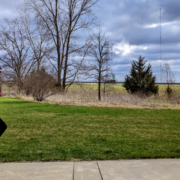Running in Rhythm
Think back to the last time you felt like this…

The first few steps are brutal. Like the rusted cogs of a long-dormant machine grinding stubbornly back into motion, your legs move. Through atrophy and entropy, you press forward.
One grueling mile passes, and what was previously agony with every step becomes discomfort approaching tolerable levels. Your back straightens a bit and your knees actually bend.
An unpleasant second mile passes, and you begin to remember that running occasionally falls in the category of pleasurable, if somewhat sadistically. Still, freedom that your spirit finds in the perfect combination of speed and strength drifts into your periphery, and you find the capacity to breathe deeply and smile a little.
And you once more admit, if only to yourself, that you are, indeed, a runner.
Now, whether that describes your first run after months of mind-numbing injury, rest, and recovery or the day after an especially tough race, workout, or long run (that last one was me after my first time hitting the trails for a long run this summer), if you have been a runner for any stretch of time, you know that feeling. You also know that the feeling will pass and you’ll be running hard again soon (whether it be a few weeks of rebuilding or a couple days of recovery).
On that note…
After some great conversations with this blog’s followers, my own friends and acquaintances, and several Strava peeps, I decided to take a moment to address the topic of rest and recovery in a bit of an uncommon way.
I should mention that my specific inspiration for compiling these thoughts right at this moment came from a recent exchange with Colin Hunter on Strava (find him here). Feel free to take a look at those details at your leisure (found here).
Along those lines, a number of other comments on the Bayshore recap post informed some of my thoughts, as well.

To the point: Rhythm
As I age in the sport of running, one of the more important developments for my training has become the sense of rhythm I feel while running.
Further still, you watch any group of runners closely enough, and you’ll notice subtle differences in the smoothness or ease of rhythm. I believe that is significantly more important than simple differences in running form or cadence.

Finding Rhythm
Any major school of thought in terms of distance running references easy running as a spectrum of effort that ends somewhere around marathon pace (steady state, critical threshold, etc.). Few spend much more time on the topic than that.
You will agree, though, that there is a significant difference between a rusty grind and a brisk trot (reference to my intro). In my mind, it is as simple as this: at some point on the spectrum of running easy, you stop feeling like you’re plodding along and start feeling like you’re actually running. That transition is what I am referring to when I talk about finding rhythm, and I would argue that distance runners should be a lot more intentional about finding and conditioning that rhythm.
Let me give an example.

Rhythm in Training
Here’s a typical week of training for me when I am in the middle of a base phase (I never actually follow this pattern consistently, but in general…):
- Monday: 60 minutes easy
- Tuesday: 90-110 minutes total, 45-60 of it at steady state
- Wednesday: 60 minutes easy
- Thursday: 90 minutes total, 30-45 of it at steady state
- Friday: 45-60 minutes easy, strides throughout
- Saturday: 120-150 minutes of progressive running (or steady state, or just easy)
- Sunday: 45-60 minutes easy
For the easy days, instead of thinking of pace or HR or power, my current thought is to let rhythm be the determiner for the appropriate amount of effort. It’s quite simple, too:
- Begin by easing into the run, assuming that the first mile (or so) will rarely feel smooth.
- Once the creaking and groaning begins to subside, be very intentional about establishing a comfortable cadence and relaxed posture.
- After the cadence and posture fall into place, maintain focus on those things and add in breathing (again, the idea being relaxed).
You should naturally fall into a level of effort that is appropriate for your body’s needs on the day. The only other factor that may make a difference is distance/time, and the easy answer to that is if you feel tired, don’t run as long. I would argue that relaxed, rhythmic run that is short will do much more for your fitness than a plodding, laborious run that is a bit longer.
This leads to the most important question on this topic…

How do you improve your rhythm?
Like everything in running, rhythm may not come naturally (especially for those returning from a long drought, whatever the reason, or first getting into running). That being the case, there are certainly specific things every runner can do (yes, even you, Eliud Kipchoge).
Improve your running economy.
The amount of energy you expend with every step matters. It matters quite a lot, in fact (thus Nike’s revolutionary shoe – the 4% – being so exceptional). The three easiest ways to improve your running economy (and thus reduce the energy output) are:

- Focus on form/posture and cadence often while running (especially during easy runs and long runs). You want a quick and light cadence, relaxed and relatively quiet shoulders, and upright torso.
- Run short and fast strides at least one day/week, ideally spread out over the course of an easy run (that’s a Lydiard thing that the running world seems to have forgotten and shouldn’t have).
Develop your general strength and mobility (GSM)
This also has a direct impact over running economy, but I am listing it separately so that it looks more important. Because it is.

- Establish and commit to a regular pre- and post-run routine that involves activating and strengthening your (1) core, (2) hips, and (3) posterior chain (low back, glutes, hamstrings, etc.). This does not have to be crazy, but it does have to be regular.
- Engage with mobility and flexibility often. Yoga’s good. So is dynamic stretching, static stretching, active isolated flexibility, myofascial release techniques, and any number of other ways to get your stiff parts moving fluidly. It’s the long game, too, so make it a habit.
Raise your aerobic ceiling
Nothing impacts the overall running experience more than aerobic capacity (for distance runners). I’m not going to try to debate the science or methodology here. I’m just going to emphasize that runners at every level of the sport live and die by their aerobic ceiling. And it’s super easy to raise it. Here’s how I suggest going about it:

- In the early stages of a training cycle/season, spend at least a few weeks doing little more than easy running (this is where the rhythm thing comes in). During that time, slowly and incrementally build volume until you are at or near your peak volume that you hope to reach during the cycle. Once there, then you begin to add workouts.
- Run as regularly as your health or situation tolerate. If you can’t run every day, find another aerobically stimulating activity to do for significant periods of time (riding, swimming, dancing, skiing, etc.) where your heart rate is elevated for the entire duration of the activity. Why? Because frequency matters a LOT in the pursuit of elevating aerobic threshold.
- Do longer workouts at slower paces. Interval training is good for only two things: (1) running harder than you are able to sustain for long periods and (2) elevating your sense of efficacy by creating short goals (individual intervals) that you can achieve successfully and find immediate gratification. If your goal is aerobic capacity, sustained hard effort running is the best option. If you can’t sustain the pace for the duration desired, then you are trying to run too fast (or perhaps too long). Over time, both of those will improve.
- Last one: the long run. We all know it’s good. We all know it’s essential. Most of us know that it’s supposed to be harder than easy effort. Few of us know that it’s returns essentially compound over time. Which means we should do lots of them (assuming one per week, still).
Let me bluntly state that the Runner’s World 12- or 16-week marathon training plan is as close to rubbish as it can be without being totally worthless. The idea that you slowly build your long run over time until you finally run your longest one 3-4 weeks before your marathon race is absurd.
The point of the long run is to build aerobic capacity and muscular endurance. Why are you waiting until a few weeks before your race to maximize that benefit?
Here’s the obvious truth that makes everyone slap their foreheads: you should be focusing on building your long run as early in the training cycle as possible so that you can then repeat that LR as many times as possible as you prepare for the race.
Actually, the same goes for training volume in general, which is also why I suggest that a marathon training cycle should be more like 20 weeks (or more), but for most, that apparently feels extreme.
Now might be a good moment to just briefly mention that we do (and have for years) help runners develop training plans. I am a firm believer that anything short of a personal, customized plan designed around your past experiences, current potential, and future goals is trash. So our approach is a lot more hands-on than most. If you think we might have something to offer you in your training, feel free to contact us any time!

A Quick Summary
It’s a long post, so let me distill it.
My premise is that I think we should spend more time focusing on finding rhythm instead of looking at numbers on our watch. I feel that easy runs are the best opportunity to practice that, as well. Additionally, doing the extra work to develop things like strength and mobility always pays off.
And as mentioned, there are nearly limitless inconsistent external factors that can contribute to these things (nutrition, sleep, time of day, prior day’s non-running activities, emotional/mental fatigue, etc.), so expect rhythm to vary (it may also, along those lines, be a very helpful way for you to evaluate which of those external things is positively or negatively influencing your running).
What more on training? Here are some related articles:
Raise the Roof: The Why and How for Aerobic Fitness
Becoming a Stronger Animal
A Well Oiled Machine












I appreciate the advice about keeping your shoulders relaxed when running. My new year’s resolution is to run a marathon later this year and I need to train now. I’ll be sure to use these tips to help my running rhythm.
Absolutely, Taylor! If it’s training and marathoning nuggets you’re after, we’ve got a lot in our material about all of that (and even offer some training services of varying degrees).
You might start by checking out the 3-part blog series on our training guide (start here: https://www.atozrunning.com/training-guide-part-1/)